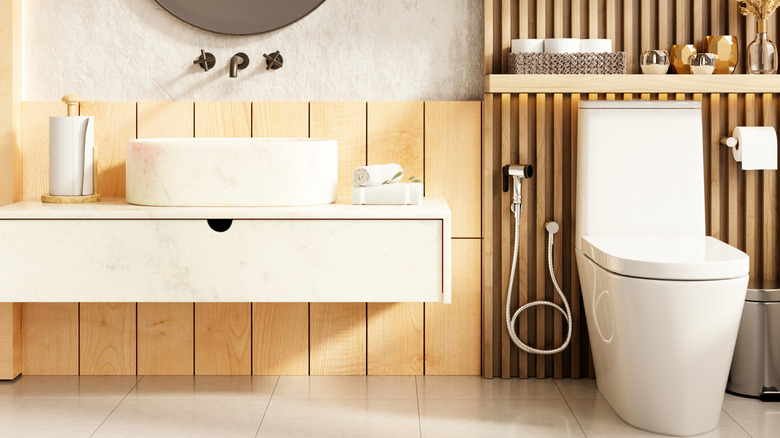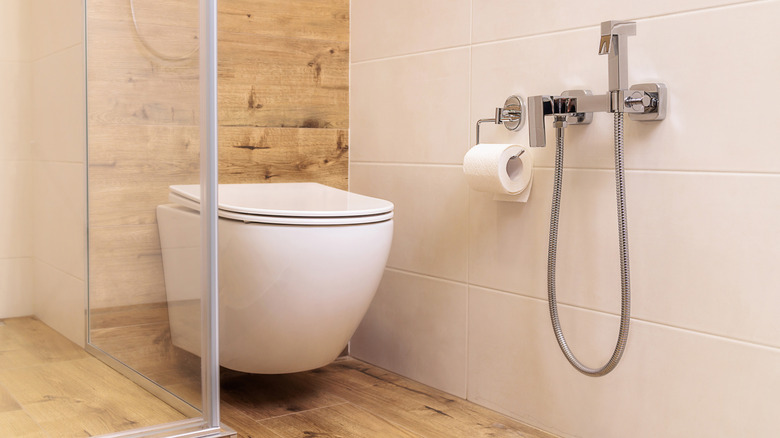Skirted Vs Concealed Toilets: What's The Difference And Which Is Worth Buying?
When it's time to upgrade your toilet, you might think it's a simple choice, but then you're hit with some options you didn't know existed. Should you get a traditional, skirted, or a concealed one? The difference is whether or not the plumbing fixtures and trapway — the curved, S-shaped pipe that connects to the floor — are visible. A traditional toilet leaves this curved pipe and the mounting bolts exposed. Both skirted and concealed toilets have a flush surface that extends from the front of the toilet all the way to the wall, but with some notable differences.
The term "skirted" describes a toilet bowl and base that form a single, continuous, smooth line to the floor. A concealed toilet also has a concealed trapway, but the tank is hidden inside the wall. This is also known as a wall-hung or in-wall toilet. The hidden tank provides a more minimalist look, since only the bowl and skirt are visible.
The choice between each of these toilets and which is worth buying in your home depends on whether simple maintenance is important to you, what type of design you prefer, and how much you want to spend. Knowing the differences between these two types of toilets is important when deciding which is right for your home.
What are the pros and cons of a skirted toilet?
A skirted toilet has some benefits and drawbacks to consider before buying. The most frequently cited benefit is the ease of cleaning. Since there are no exposed curves, bolts, or recesses along the base, wiping down the flat surface is quick and easy, which saves time when cleaning the bathroom. The overall look is another selling point, which makes it easy to blend into a minimalist home design. The continuous base doesn't have the visual clutter of a traditional toilet, and it has a more polished look. Many skirted toilets come with optional features, like soft-close seats or advanced flushing systems that many traditional toilets don't have.
The cost to install a skirted toilet is higher than a non-skirted model, often at a price of $400 or more. This installation is more complicated because the hidden trapway and bolts make it harder to access, which can increase the labor costs for installation. The design of the toilet makes it larger and bulkier than traditional ones, which makes it difficult to install in smaller bathrooms. Another downside to a skirted toilet is that the enclosed design can make it harder to replace the toilet seat or repair it, which can lead to increased labor costs.
The benefits and downsides of a concealed toilet
The pros and cons of concealed toilets are different from a skirted model. One of the biggest benefits of this design is that it saves space in the bathroom. When there isn't a tank or base resting on the floor, it's much easier to clean. Another benefit is the adjustable height, which can be set during installation to accommodate personal preferences or accessibility needs.
The price point for concealed toilets is higher than that of standard toilets, often between $300 and $900 for the entire system, including the bowl, in-wall tank, and flush plate. The installation is complex and expensive, which requires opening the wall, installing a metal frame, and rerouting the plumbing. Because of this, concealed toilets are most often seen in newly constructed homes or complete bathroom renovations. While the internal tank parts are accessible through a flush plate, long-term maintenance can be difficult. If it leaks behind the wall, getting to the parts can be costly, since it might require opening up the entire wall. In the end, a concealed toilet has the most streamlined and modern look while being the easiest to clean, but it costs more and requires a serious commitment to a bathroom renovation project. Homeowners will need to know about the different styles of toilets to decide which is best for them.


